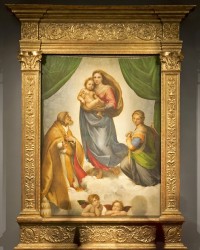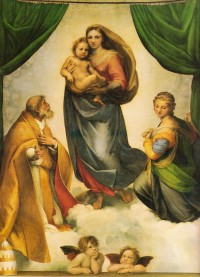 The Sistine Madonna, the iconic Madonna with saints and cherubs that is the last painting Raphael finished with his own hands before his premature death, turns 500 years old this year. The Gemäldegalerie Alte Meister (Old Masters Picture Gallery) in Dresden, proud owner of the masterpiece, is putting on a major new exhibition to celebrate the quincentennial. In honor of the special occasion, the painting has been reframed in what is basically a gilded temple, complete with modified Corinthian columns and a huge cornice.
The Sistine Madonna, the iconic Madonna with saints and cherubs that is the last painting Raphael finished with his own hands before his premature death, turns 500 years old this year. The Gemäldegalerie Alte Meister (Old Masters Picture Gallery) in Dresden, proud owner of the masterpiece, is putting on a major new exhibition to celebrate the quincentennial. In honor of the special occasion, the painting has been reframed in what is basically a gilded temple, complete with modified Corinthian columns and a huge cornice.
In 1512, Raphael was commissioned by Pope Julius II to create an altarpiece of the Virgin Mary and Christ Child for the newly-built Benedictine Monastery of San Sisto in Piacenza. The pontiff required that the painting include Saint Sixtus, in tribute to his uncle Pope Sixtus IV, and Saint Barbara, one of Fourteen Holy Helpers whose powers of intercession are deemed particularly keen. Raphael finished the painting around 1513 or 1514. He died in 1520, and although he designed and worked on other Madonnas and paintings in the six or seven intervening years, his assistants did much of the work.
The painting remained enshrined over the altar in the little-known monastery until 1754 when Augustus III, absentee King of Poland and Elector of Saxony, purchased it from the Benedictines for 110,000-120,000 francs. Augustus III, like his father and grandfather before him, was an avid art collector. They created a world-class collection of Old Master paintings with the Sistine Madonna as the jewel in the crown. Legend has it that Augustus moved his throne so the painting could have the best light in the room, but the entire collection had been moved from Dresden Castle to the more spacious Stallgebäude (the Electors’ Stable Building) next door in 1747; thus, either Augustus wanted some alone time in the throne room with the Raphael for a while, or the story is apocryphal.
 The only Raphael in Germany, the Sistine Madonna was an immediate sensation. Even though Protestant Saxony was uneasy about its very recent Papist extraction and general Catholic imagery, the painting’s embrace of classicism (the Madonna could just as easily be a Juno and the composition follows the ancient principle of the sectio aurea or golden ratio) and its self-aware presentation as a piece of art (see the green curtains in the upper corners and the cherubs down below who rest against a balustrade much like the altar which the altarpiece was created to adorn) made it a favorite with budding Romantics and classicists alike. Goethe wrote a song about it; Wagner made special trips to Dresden just to see it; Alfred Rethel said, “I would not swap for a kingdom the delight I have had from standing before this picture,” and that was before he went insane.
The only Raphael in Germany, the Sistine Madonna was an immediate sensation. Even though Protestant Saxony was uneasy about its very recent Papist extraction and general Catholic imagery, the painting’s embrace of classicism (the Madonna could just as easily be a Juno and the composition follows the ancient principle of the sectio aurea or golden ratio) and its self-aware presentation as a piece of art (see the green curtains in the upper corners and the cherubs down below who rest against a balustrade much like the altar which the altarpiece was created to adorn) made it a favorite with budding Romantics and classicists alike. Goethe wrote a song about it; Wagner made special trips to Dresden just to see it; Alfred Rethel said, “I would not swap for a kingdom the delight I have had from standing before this picture,” and that was before he went insane.
As war loomed in 1938, the Gemäldegalerie Alte Meister closed up shop and removed its collection to safety in underground storage in Switzerland. Thus the Raphael survived the firebombing of Dresden that so severely damaged the gallery it wasn’t fully reconstructed until 1960. It also survived the Soviet army, which according to its own press had “saved” the precious painting from a flooded out cave. In fact the storage area was climate-controlled and entirely functional; the Soviets simply felt entitled to claim any and all of the enemy’s treasures as payment for all of their own cultural patrimony looted by the Nazis (see this excellent article for more on the subject).
In 1955, two years after the death of Stalin, the Soviet Union decide to return the Sistine Madonna to Germany as a gesture of goodwill to strengthen relations between the countries. The jewel in the crown went back on display in the Gemäldegalerie Alte Meister.
 The 500th anniversary exhibit opened Saturday, May 26 and continues through August 26. It covers the painting’s checkered history in four sections: Raphael in Rome — an examination of the context in which Raphael painted the piece; Augustus III’s acquisition and the move from Piacenza to Dresden; the influence of the Sistine Madonna on art, literature, music and design; and lastly, a romp through the rich separate life of the two little cherubs at the bottom who were first copied on their own in 1800 and have been on everything from posters to coasters to t-shirts ever since.
The 500th anniversary exhibit opened Saturday, May 26 and continues through August 26. It covers the painting’s checkered history in four sections: Raphael in Rome — an examination of the context in which Raphael painted the piece; Augustus III’s acquisition and the move from Piacenza to Dresden; the influence of the Sistine Madonna on art, literature, music and design; and lastly, a romp through the rich separate life of the two little cherubs at the bottom who were first copied on their own in 1800 and have been on everything from posters to coasters to t-shirts ever since.
Who is Arthur Renkel?
Googling just the name turns up a lot of ancestry sites. Adding the word ‘insane’ turns up this entry. :giggle:
That’s probably because his name was actually Alfred Rethel. I have no idea why I invented Arthur Renkel in his place. :blush: Rethel was a German Romantic whose later work is very much up your alley.
This is relevant to my interests, yes. :skull:
Thanks for this wonderful summary Liv. I’ve recently been wading through the scholarly literature on the curtain alone… what a headache!
The prolific fame of the cherubs vs the intense ambiguity of the curtain are just one of many wonderful contrasts to be found in this piece.
Many Kind Regards
H
It’s incredible how much material there is out there about the Sistine Madonna. You are a brave man to attempt to wade through any part of it.
Thank you for the kind words. :thanks:
Hmmm?! It does look rather like a neo-quattrocento gallery frame, doesn’t it? I would certainly have liked a deeper setting with more architecture, to make better sense of the drapery effect (although there are some rather flat gilded affairs here in Florentine churches). What do we know about the original placement in San Sisto in Piacenza? My hasty web search wasn’t much help!
All I know about the San Sisto setting is they had a gilded frame which Augustus III did not purchase along with the painting. The monks put up a copy of the Sistine Madonna in the old frame. This is how it looks now . Inside the gloriously insane scrollwork setting you can see the copy is in an elegant, large but fairly simple crown molding-style gilded frame. It bet it’s the same one the Raphael used to be in. These little churches keep everything.
The Dresden frame that just got replaced (see here) was a little more decorated with some twee florals and a monocrhome checkerboard on the outside edge.
:hattip: :giggle: :facepalm: 👿 😮 😥 😎 :confused: :chicken: :boogie: 🙁 :love: :no: :notworthy: :ohnoes: :shifty: :skull: :thanks: :angry: :blankstare: :yes: :blush: 😉 <3 the emoticons :p
Madonna !
Highest Queen of all the world!
Let me in the above blue,
With all heaven’s stars unfurled,
See your hidden mystery, too.
Approve the tender, serious
Stir of the human heart,
And in love’s sacred bliss,
Raise it higher, through your art.